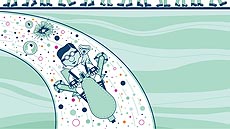Ten things you might not know about particle accelerators
 |
From accelerators unexpectedly beneath your feet to a ferret that once cleaned accelerator components, symmetry shares some lesser-known facts about particle accelerators. Image: Sandbox Studio |
The Large Hadron Collider at CERN laboratory has made its way into popular culture: Comedian John Stewart jokes about it on "The Daily Show," character Sheldon Cooper dreams about it on "The Big Bang Theory" and fictional villains steal fictional antimatter from it in Angels & Demons.
Despite their uptick in popularity, particle accelerators still have secrets to share. With input from scientists at laboratories and institutions worldwide, symmetry has compiled a list of 10 things you might not know about particle accelerators.
There are more than 30,000 accelerators in operation around the world.
Accelerators are all over the place, doing a variety of jobs. They may be best known for their role in particle physics research, but their other talents include: creating tumor-destroying beams to fight cancer; killing bacteria to prevent food-borne illnesses; developing better materials to produce more effective diapers and shrink wrap; and helping scientists improve fuel injection to make more efficient vehicles.
One of the longest modern buildings in the world was built for a particle accelerator.
Linear accelerators, or linacs for short, are designed to hurl a beam of particles in a straight line. In general, the longer the linac, the more powerful the particle punch. The linear accelerator at SLAC National Accelerator Laboratory, near San Francisco, is the largest on the planet.
SLAC's klystron gallery, a building that houses components that power the accelerator, sits atop the accelerator. It's one of the world's longest modern buildings. Overall, it's a little less than 2 miles long, a feature that prompts laboratory employees to hold an annual footrace around its perimeter.
Particle accelerators are the closest things we have to time machines, according to Stephen Hawking.
In 2010, physicist Stephen Hawking wrote an article for the UK paper the Daily Mail explaining how it might be possible to travel through time. We would just need a particle accelerator large enough to accelerate humans the way we accelerate particles, he said.
A person-accelerator with the capabilities of the Large Hadron Collider would move its passengers at close to the speed of light. Because of the effects of special relativity, a period of time that would appear to someone outside the machine to last several years would seem to the accelerating passengers to last only a few days. By the time they stepped off the LHC ride, they would be younger than the rest of us.
Hawking wasn't actually proposing we try to build such a machine. But he was pointing out a way that time travel already happens today. For example, particles called pi mesons are normally short-lived; they disintegrate after mere millionths of a second. But when they are accelerated to nearly the speed of light, their lifetimes expand dramatically. It seems that these particles are traveling in time, or at least experiencing time more slowly relative to other particles.
Read more
—Sarah Witman
|